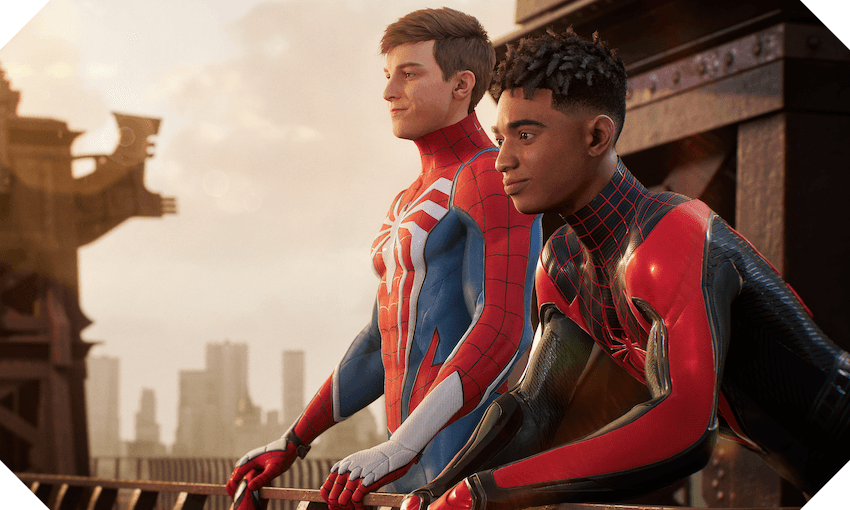We’re inundated with visits to the various Marvel universes these days – but Spider-Man 2 is a rare example that gets its source material completely right.
Mild spoilers for Spider-Man 2 follow.
What is it?
It is, helpfully, what is says on the tin: a follow-up to the wildly successful Spider-Man game that dropped on the PS4 five years ago. Not only was the game a huge success, arguably one of the best games on the console, it managed to be a rare licensed game that completely nailed the spirit of its source material. It was fun, funny, heartbreaking and shockingly human – everything Peter Parker should be.
Spider-Man 2 picks up a few years after the first game, and ropes in one of the most adored parts of the canon: Venom. The symbiote, one of Spider-Man’s most notorious nemeses, showed up in the stinger for the first game, and the speculation about how he would come into play in the sequel was wild. And, perhaps unsurprisingly, Insomniac has absolutely nailed it.
The good
The original Spider-Man (and its expansion/sequel Miles Morales) struck a winning formula. It didn’t just nail a great Spider-Man story, it managed to give people the thrill of actually being the hero of the boroughs. Traversing an open world has never been more fun than swinging across streets and buildings through Manhattan, from web to web to web.
The main additions are twofold. The first and most obvious is that there are Spider-Men, plural, in this game. Peter Parker and Miles Morales take up the mantle simultaneously, and the player can switch between them at the flick of a button. While this has obvious storytelling advantages – Insomniac pitting the wants, fears and peculiarities of these characters against each other brings some of the campaign’s best moments – it also lets the player get a greater understanding of each one by contrast.
The other is the addition of Web Wings. Now that the world is bigger, adding on the boroughs of Brooklyn and Queens across the river from Manhattan, swinging down streets and avenues isn’t fast enough. The Web Wings adds another layer of complexity, and genuine fun, to traversing, allowing both spidermen to glide, at pace, to their destination. It’s a rare game that makes me want to not use fast travel to instantly get to a destination, and it’s a very wise, and crucial choice, that Insomniac gives players a chance to beeline through their expanded world.
Otherwise, the game is more of the (very good) same. Insomniac clearly has a handle on this world and how to play in it. The additions to the world, including Parker’s troubled friend Harry Osbourne, and the completely psychopathic Kraven the Hunter, gel well, as does the work to deepen the world around Miles Morales, and what it means for him to be a working class Black man who also, yes, happens to be a superhero. Obviously, the gameplay and graphics are exemplary – it doesn’t just feel good to play as Spider-Man, it looks really damn great. But it’s a triple-A game, this is no surprise. (Also, thankfully no surprise, are the world-leading accessibility options that allow any player, regardless of ability, to engage with the game.)
But where Spider-Man goes from feeling good, even great, to feeling special is in the smaller moments. My favourite moment from the game isn’t even a part of the main story, it’s a little moment just past the halfway mark, where Spider-Man follows up on a particularly frustrating collectible quest from the first game – corralling the birds that an unhoused man diligently takes care of. The mission involves no combat, and nothing more than swinging around the city. But the weight attached to it, and how it reminds Peter Parker, and therefore the player, of the importance of saving an individual, rather than a borough, or entire city, resonates through the game. It’s the kind of thing that a smaller game wouldn’t be able to include, or other massive games might ignore in favour of bombast. It shows, once again, how well Insomniac has nailed this.
In a strange way, the games it most reminded me of were the Spyro games (fittingly, also developed by Insomniac). Full of life, full of colour, full of heart, but also, crucially, full of small moments that push the game away from being button-mashing and into, well, art.
The not-so-good
While I am a firm believer in the idiom “if it ain’t broke don’t fix it”, there’s a smidgen of Spider-Man 2 that is simply more, rather than pushing the game, or its world, further forward. It’s a credit to how well the developers nailed the character, and the experience of playing as that character, the first time around – but I can’t help but wonder how much further they can take this version of Spider-Man.
The verdict
It seems churlish to complain about a game being consistently excellent, rather than surprising. And consistently excellent is what Spider-Man 2 is. It’s important to acknowledge that, especially in an age where games of this scale can feel like content to ensnare rather than art to experience.
Spider-Man 2 does what every comic book game should do: it makes you feel like the character you’ve been a fan of since you were a kid. That’s no small feat to pull off once, let alone twice.
Spider-Man 2 is out on the PS5 now. This game was completed 100% for review.



